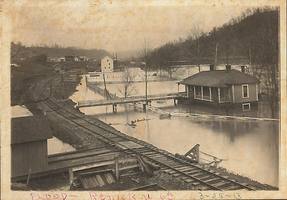
By the late 19th century, the farmer’s plow and woodman’s ax had removed much of West Virginia’s rich soil and lush forests, increasing the risk of heavy rains causing floods in creeks and rivers downstream in the watershed. In 1884, the Ohio River was the scene of a major flood that swept away countless homes. In 1913, the Ohio again flooded, and this time the high water brought with it a corresponding flood of public protest. Former president Theodore Roosevelt complained that millions of dollars were going to flood aid, but not one penny had been spent on flood control. President Woodrow Wilson appointed a special commission that recommended the erection of levees and the construction of flood-reducing reservoirs. However, action was limited until the 1930s.
In that decade, the federal government began building massive flood-control projects in West Virginia. The work continued for the next half-century. The first project completed was the dam on Tygart Valley River, designed for flood control and other purposes and finished in 1938. Bluestone Dam, on the New River above Hinton, was built by the U.S. Army Corps of Engineers in the 1940s. Several other Corps of Engineers flood-control dams followed, including Summersville, Sutton, and East Lynn in the 1960s, and Burnsville and Beech Fork in the 1970s. R. D. Bailey Dam was completed in 1980 and Stonewall Jackson, the last of the big flood-control dams, in 1988.
Floodwalls were also built, including the wall that protects Huntington from the Ohio and Guyandotte rivers. Because Huntington was home to so many essential defense plants, work was allowed to continue during World War II. Begun in 1938, the floodwall was completed in 1943. Floodwalls similar to that at Huntington were completed in Parkersburg in 1950 and Point Pleasant in 1951. There are also floodwalls at Ceredo, Kenova, Williamson, West Williamson and Matewan, and the Army Corps has plans for a floodwall at Milton.
Today the Corps of Engineers has dozens of flood-control projects in the state, including levees and floodwalls as well as dams and lakes. Although built primarily with flood control in mind, the man-made lakes have become recreational meccas, enjoyed by many thousands of people each year. In contrast, the locks and dams on the Ohio and Kanawha rivers, also built by the Corps of Engineers, have no flood-control function. These dams were built solely for navigation purposes, to provide a steady, dependable stream depth so that the rivers remain navigable year-round.
Flood-control dams operate on a simple storage principle, applied on a massive scale. Typically the water level is lowered in the fall to allow the dams to catch the run-off from the heavy rains of spring. Thus the lake waters rise to summer levels, complementing the recreational needs of boaters and fishermen. In addition to these cyclical changes, each dam is designed with a large reserve area to impound the waters of extreme floods. These reservations are rarely if ever under water.
Despite flood-control efforts, West Virginia remains prone to damaging floods. A flood on April 5, 1977, along the Tug Fork of the Big Sandy River saw 11 counties declared major disaster areas. In November 1985, record flooding in central and eastern West Virginia, especially in the headstream areas of the Greenbrier, Potomac, Monongahela and Little Kanawha rivers, resulted in 47 deaths and hundreds of millions of dollars in property damage. Occasionally, floods strike even in watersheds protected by dams, as was the case in the Little Kanawha Valley downstream of the Burnsville Dam in 1985 and 1994. In 2002, floods in southern West Virginia breathed new life into a long-standing controversy about the role of timbering and coal mining—especially mountaintop removal mining producing floods. In 2016, flooding killed 23 people in Clay, Greenbrier, Kanawha, and Nicholas counties.
This Article was written by James E. Casto
Last Revised on July 11, 2023
Related Articles
Sources
Johnson, Leland R. Men, Mountains, and Rivers. Washington: United States Government Printing Office, 1977.
Casto, James E. Towboat on the Ohio. Lexington: University Press of Kentucky, 1995.
Cite This Article
Casto, James E. "Flood Control." e-WV: The West Virginia Encyclopedia. 11 July 2023. Web. 26 July 2024.


Comments?
There aren't any comments for this article yet.
Click here to read and contribute to the discussion →